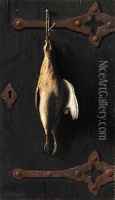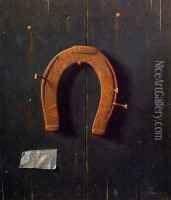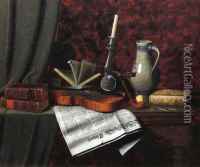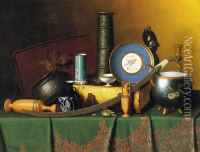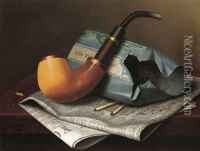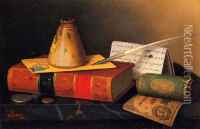William Michael Harnett Paintings
William Michael Harnett was an Irish-American painter known for his still life works and is often considered one of the greatest American still life painters of the 19th century. Born in Clonakilty, County Cork, Ireland, on August 10, 1848, Harnett emigrated with his family to the United States in his childhood, eventually settling in Philadelphia. He studied at the Pennsylvania Academy of the Fine Arts and later at the Cooper Union in New York City, honing his skills in painting that would distinguish him in his career.
Harnett gained fame for his highly detailed renderings of everyday objects, imbuing them with a sense of tangible realism that was unparalleled at the time. His style is categorized under the trompe-l'œil genre, a French term meaning 'deceive the eye,' which describes his method of creating illusionistic artworks that tricked viewers into thinking they were looking at actual objects. His paintings often featured items like books, musical instruments, and household items, meticulously arranged and painted with such detail that they appeared three-dimensional.
Throughout his career, Harnett traveled extensively in Europe, where he was influenced by 17th-century Dutch still life painters, incorporating elements of their technique into his own work. Despite his European influences, Harnett's themes were deeply American, often reflecting the cultural and social atmosphere of the United States during his lifetime.
Harnett's life was unfortunately cut short when he died of kidney disease on October 29, 1892, in New York City. His legacy, however, continues to influence the field of still life painting, with his works housed in major museums across the United States, including the Metropolitan Museum of Art, the Smithsonian American Art Museum, and the Philadelphia Museum of Art. His meticulous attention to detail and his skill in the trompe-l'œil technique have left a lasting mark on American art history.

